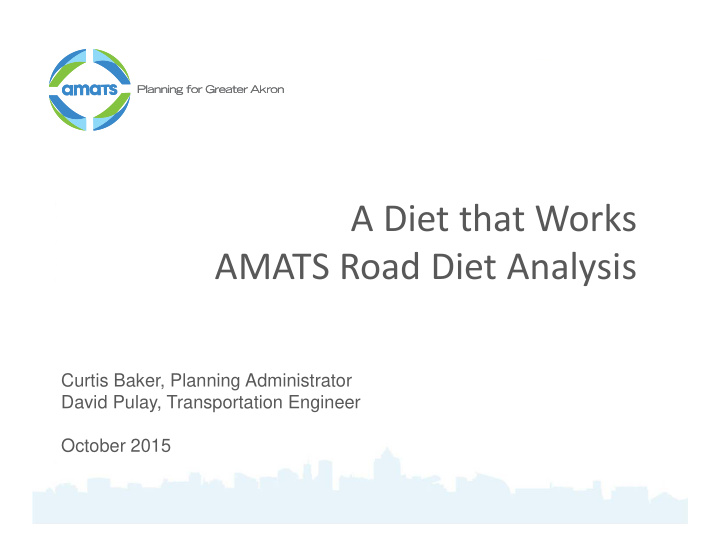



A Diet that Works AMATS Road Diet Analysis Curtis Baker, Planning Administrator David Pulay, Transportation Engineer October 2015
Overview • What is a Road Diet? • The Big Picture – Why does an MPO care about Road Diets? • AMATS Road Diet Analysis/Examples
What is a Road Diet? • Reduces the number lanes on a roadway • Most common conversion is four lanes to three lanes • One lane in each direction with a continuous turn lane • Dropped lane width is allocated to other users • Same pavement width, new lane configuration • Very little additional infrastructure cost
Typical Configuration
Benefits of a Road Diet • Safety – Overall crash reduction of 19 to 47 percent – Less rear ‐ end and left turn crashes through use of a dedicated left turn lane – Calming effect on speed • Fewer lanes for pedestrians to cross • Extra width can accommodate other transportation modes such as bikes
Benefits of a Road Diet • Smoother traffic flow, less slow and go flow • Best use of pavement when the capacity of a roadway is greater than the demand – Highways designed in 50’s and 60’s based on the current growth patterns – Population projections never materialized
Why We Care About Road Diets • Transportation Funding Difficulties • Regional Demographics • Connecting Communities/Complete Streets • Re ‐ imagining Spaces
Transportation Funding Difficulties • Funding has remained unchanged while project costs continue to rise • Bike and pedestrian connections often foiled by right ‐ of ‐ way/acquisition costs • We can create important connections with minimal cost
• Loss of population • Lower traffic counts
Connecting Communities and the Importance of Complete Streets
Complete Streets
Re ‐ imagining Our Community N Main St Akron ‐ Existing
Re ‐ imagining Our Community N Main St Akron – During Better Block Photo: Tim Fitzwater
Re ‐ imagining Our Community N Main St Akron ‐ Existing
N Main St Akron – During Better Block
Tools Baton Rouge Tempera Paint & Duct Tape StreetMix.com
The AMATS Road Diet Analysis • Goal was to compile a list of streets where a road diet could be applied • Start with an accurate inventory of roadways – GIS Database – ODOT Office of Technical Services – Highway Maintenance Wolf Ledges Pkwy Akron
The AMATS Road Diet Analysis • Reduce the inventory by eliminating – Interstates and freeways – Divided roadways (freeway look ‐ alikes) – Roadways with only two lanes • In rare cases three lane roads and five lane roads can receive a road diet Wolf Ledges Pkwy Akron
The AMATS Road Diet Analysis • Three lane roads must have unusually wide lanes – Reduce width of each lane – Allocate space for bike lane
The AMATS Road Diet Analysis • Road diet applied to five lane roads has to have extra space well defined
The AMATS Road Diet Analysis • Find average daily traffic (ADT) – Tier One: less than 10,000 – Tier Two: 10,000 to 15,000 – Tier Three: 15,000 to 20,000 – Over 20,000 is probably not a good choice Wolf Ledges Pkwy Akron
The AMATS Road Diet Analysis • Determine peak hour volume – If this is not provided it is usually 8 ‐ 12% of the ADT • Determine directional peak hour volume – If this is not provided use “engineering judgment” – Peak hour directional volume less than 800 ‐ 900
The AMATS Road Diet Analysis • Additional Analysis Recommended – Tier 2 roadways (ADT 10,000 ‐ 15,000) key intersections should to be analyzed, intersection spacing and length of queues considered – Tier 3 roadways (ADT 15,000 ‐ 20,000) key intersections should to be analyzed and corridor analysis for overall level of service
The AMATS Road Diet Analysis • Additional Considerations – Roadway function and it’s environment – Continuity – Railroad tracks ‐ queues twice as long with less lanes – Grades and slow moving vehicles – Frequently stopping vehicles, especially buses – Population and traffic volume trends Opportunity Pkwy Akron
The AMATS Road Diet Analysis • Successful Implementation – All stakeholders are part of the planning process – Coordinate with resurfacing projects/schedules – Community support
Road Diet Examples Copley Rd (SR 162) in Akron, ADT = 13,300
Road Diet Examples South St in Akron, ADT = 1,920
Road Diet Examples South Main St in Summit Co., ADT ≈ 12,000
Road Diet Projects Planned • Cedar St in Akron, three one ‐ way lanes + parking, ADT = 9,370
Road Diet Projects Planned • Exchange St in Akron, four one ‐ way lanes, ADT = 10,390
High Ranking Candidates Maple St in Akron, ADT = 5,760
High Ranking Candidates Wolf Ledges Pkwy in Akron, ADT = 8,400
High Ranking Candidates E. Exchange St in Akron, ADT ≈ 10,000
High Ranking Candidates N. Main St in Akron, ADT ≈ 10,000
Questions? Curtis Baker Planning Administrator, AMATS Email: cbaker@akronohio.gov David Pulay, PE Transportation Engineer, AMATS Email: dpulay@akronohio.gov www.amatsplanning.org
Recommend
More recommend